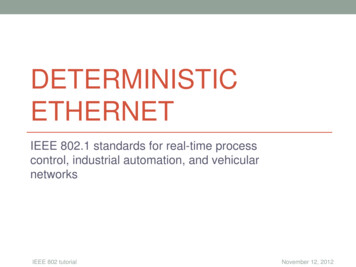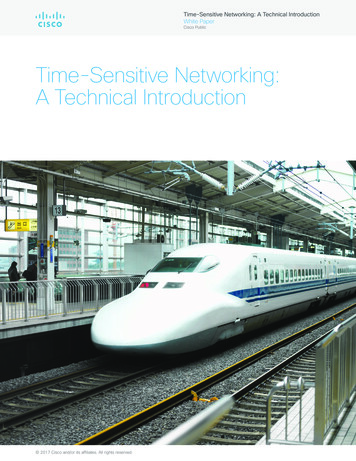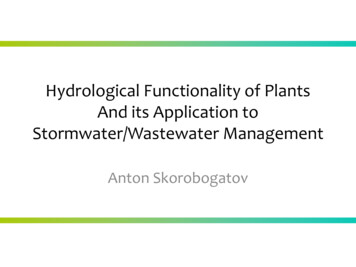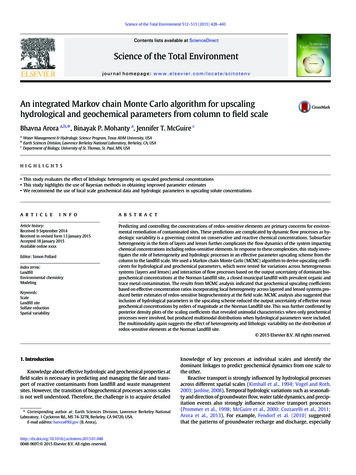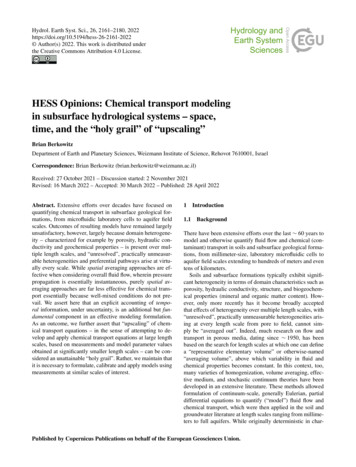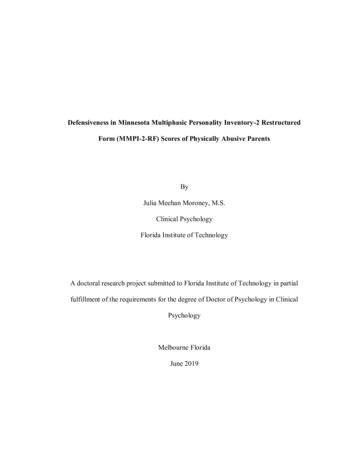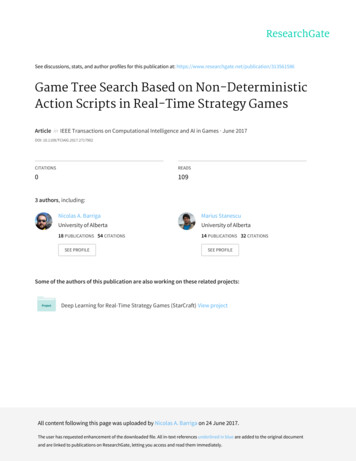
Transcription
EGU GENERAL ASSEMBLYVienna,3-8 April 2011UNIVERSITY OF BOLOGNAAlma Mater StudiorumDATAERRORResearch Project2011 EGU General AssemblyVienna, 3 - 8 April 2011Is deterministic physically-based hydrological modelinga feasible target? Incorporating physical knowledge instochastic modeling of uncertain systemsAlberto MontanariFaculty of EngineeringUniversity of Bolognaalberto.montanari@unibo.itDemetris KoutsoyiannisNational Technical Universityof Athensdk@ntua.itia.grWork carried out under the framework of the Research Project DATAERRORDATAERROR(Uncertainty estimation for precipitation and river discharge data.Effects on water resources planning and flood risk management)Ministry of Education, University and Research - ItalyThis presentation is available for download at the website: http://www.albertomontanari.itInformation: alberto.montanari@unibo.it
EGU GENERAL ASSEMBLYVienna,3-8 April 2011UNIVERSITY OF BOLOGNAAlma Mater StudiorumDATAERRORResearch ProjectA premise on terminologyPhysically-based, spatially-distributed and deterministic are often used assynonyms. This is not correct. Physically-based model: based on the application of the laws ofphysics. In hydrology, the most used physical laws are theNewton’s law of the gravitation and the laws of conservation ofmass, energy and momentum.Sir Isaac Newton(1689, by Godfrey Kneller)Spatially-distributed model: model’s equations are applied at local instead ofcatchment scale. Spatial discretization is obtained by subdividing the catchment insubunits (subcatchments, regular grids, etc).Deterministic model: model in which outcomes are precisely determined throughknown relationships among states and events, without any room for random variation.In such model, a given input will always produce the same outputThis presentation is available for download at the website: http://www.albertomontanari.itInformation: alberto.montanari@unibo.it
EGU GENERAL ASSEMBLYVienna,3-8 April 2011UNIVERSITY OF BOLOGNAAlma Mater StudiorumDATAERRORResearch ProjectA premise on terminologyFluid mechanics obeys the laws of physics. However: Most flows are turbulent and thus can be described only probabilistically (note that thestress tensor in turbulent flows involves covariances of velocities).Even viscous flows are au fond described in statistical thermodynamical termsmacroscopically lumping interactions at the molecular level.It follows that: A physically-based model is not necessarily deterministic.A hydrological model should, in addition to be physically-based, also consider chemistry,ecology, etc.In view of the extreme complexity, diversity and heterogeneity of meteorological andhydrological processes (rainfall, soil properties ) physically-based equations aretypically applied at local (small spatial) scale. It follows that: A physically-based model often requires a spatially-distributed representation.This presentation is available for download at the website: http://www.albertomontanari.itInformation: alberto.montanari@unibo.it
EGU GENERAL ASSEMBLYVienna,3-8 April 2011DATAERRORResearch ProjectUNIVERSITY OF BOLOGNAAlma Mater StudiorumA premise on terminologyIn fact, some uncertainty is always present in hydrologicalmodeling. Such uncertainty is not related to limitedknowledge (epistemic uncertainty) but is ratherunavoidable.It follows that a deterministic representation is not possiblein catchment hydrology.The most comprehensive way of dealing with uncertaintyis statistics, through the theory of probability.Figure taken from http://hydrology.pnl.gov/Therefore a stochastic representation is unavoidable in catchment hydrology(sorry for that.).The way forward is the stochastic physically-based model, a classical concept that needs to bebrought in new light.This presentation is available for download at the website: http://www.albertomontanari.itInformation: alberto.montanari@unibo.it
EGU GENERAL ASSEMBLYVienna,3-8 April 2011DATAERRORResearch ProjectUNIVERSITY OF BOLOGNAAlma Mater StudiorumFormulating a physically-based modelwithin a stochastic frameworkHydrological model:in a deterministic framework, the hydrological model is usually defined as a singlevalued transformation expressed by the general relationship:Qp S (εε, I)where Qp is the model prediction, S expresses the model structure, I is the input datavector and ε the parameter vector.In the stochastic framework, the hydrological model is expressed in stochastic terms,namely (Koutsoyiannis, 2010):fQp (Qp) K fε, I(εε, I)wherefindicates the probability density function, anddepends on modelKis a transfer operator thatS.This presentation is available for download at the website: http://www.albertomontanari.itInformation: alberto.montanari@unibo.it
EGU GENERAL ASSEMBLYVienna,3-8 April 2011UNIVERSITY OF BOLOGNAAlma Mater StudiorumDATAERRORResearch ProjectFormulating a physically-based modelwithin a stochastic frameworkAssuming a single-valued (i.e. deterministic) transformationS(εε, I) as in previous slide,the operator K will be the Frobenius-Perron operator (e.g. Koutsoyiannis, 2010).However, K can be generalized to represent a so-called stochastic operator, whichcorresponds to one-to-many transformationsS.A stochastic operator can be defined using a stochastic kernel k(e, ε, I) (with eintuitively reflecting a deviation from a single-valued transformation; in our case itindicates the model error) having the propertiesk(e, ε, I) 0and e k(e, ε, I) de 1This presentation is available for download at the website: http://www.albertomontanari.itInformation: alberto.montanari@unibo.it
EGU GENERAL ASSEMBLYVienna,3-8 April 2011UNIVERSITY OF BOLOGNAAlma Mater StudiorumDATAERRORResearch ProjectFormulating a physically-based modelwithin a stochastic frameworkSpecifically, the operator K applying on fε, IMackey, 1985, p. 101):(ε, I) is then defined as (Lasota andK f ε, I(ε, I) ε I k(e, ε, I) fε, I (ε, I) dε dIIf the random variables ε and I are independent, the model can be written in the form:fQp(Qp) K [fε(e) fI (I)]fQp (Qp) ε I k(e, ε, I) fε (εε) fI (I) dε dIThis presentation is available for download at the website: http://www.albertomontanari.itInformation: alberto.montanari@unibo.it
EGU GENERAL ASSEMBLYVienna,3-8 April 2011UNIVERSITY OF BOLOGNAAlma Mater StudiorumDATAERRORResearch ProjectFormulating a physically-based modelwithin a stochastic frameworkEstimation of prediction uncertainty:Further assumptions:1) model error is assumed to be independent of input data error and modelparameters.2) Prediction is decomposed in two additive terms, i.e. :Qp S(ε, I) ewhere S represents the deterministic part and the structural error e has density fe(e).3) Kernel independent of ε,I (depending on e only), i.e.:k(e, ε, I) fe(e)By substituting in the equation derived in the previous slide we obtain:fQp(Qp) ε I fe(Qp - S(ε, I)) fε (ε) fI (I) dε dIThis presentation is available for download at the website: http://www.albertomontanari.itInformation: alberto.montanari@unibo.it
EGU GENERAL ASSEMBLYVienna,3-8 April 2011UNIVERSITY OF BOLOGNAAlma Mater StudiorumDATAERRORResearch ProjectFormulating a physically-based modelwithin a stochastic frameworkSymbols:- Qptrue (unknown) value of the hydrological variable to be predictedε,I)- S(εDeterministic hydrological model-eModel structural error-εModel parameter vector-IInput data vectorFrom the deterministic formulation:Qp S(ε, I)to the stochastic simulation:fQp(Qp) ε I fe(Qp - S(ε, I)) fε(ε) fI(I) dε dIThis presentation is available for download at the website: http://www.albertomontanari.itInformation: alberto.montanari@unibo.it
EGU GENERAL ASSEMBLYVienna,3-8 April 2011UNIVERSITY OF BOLOGNAAlma Mater StudiorumDATAERRORResearch ProjectFormulating a physically-based modelwithin a stochastic frameworkAn example of application: model is generic and possibly physically-based. Let usassume that input data uncertainty can be neglected, and that probability distributionsof model error and parameters are known.Pick up a parameter vector εfrom the model parameterspace accordingly toprobability fε(εε)Compute modeloutput and add nrealisation of modelerror from probabilitydistribution fe(e)Input data vector(certain)Obtain n jpoints lying onfQp (Qp) andinfer :1)computational demands;2)estimate fε (εε) and fe (e)This presentation is available for download at the website: http://www.albertomontanari.itInformation: alberto.montanari@unibo.it
EGU GENERAL ASSEMBLYVienna,3-8 April 2011UNIVERSITY OF BOLOGNAAlma Mater StudiorumDATAERRORResearch ProjectExample: Leo Creek at Fanano (Italy)(Courtesy by: Elena Montosi)This presentation is available for download at the website: http://www.albertomontanari.itInformation: alberto.montanari@unibo.it
EGU GENERAL ASSEMBLYVienna,3-8 April 2011UNIVERSITY OF BOLOGNAAlma Mater StudiorumDATAERRORResearch ProjectEstimation of the predictive distributionRainfall runoff model: AFFDEF – Daily time scale – Conceptual , 7 parametersParameter distribution: estimated by using DREAM (Vrugt and Robinson, 2007)Generation of random samples of model error: by using the meta – Gaussian approach(Montanari and Brath, 2004; Montanari and Grossi, 2008).This presentation is available for download at the website: http://www.albertomontanari.itInformation: alberto.montanari@unibo.it
EGU GENERAL ASSEMBLYVienna,3-8 April 2011UNIVERSITY OF BOLOGNAAlma Mater StudiorumDATAERRORResearch ProjectResearch challengesTo include a physically-based model within a stochastic framework is in principle easy.Nevertheless, relevant research challenges need to be addressed: numerical integration (e.g. by Monte Carlo method) is computationally intensive andmay result prohibitive for spatially-distributed models. There is the need to developefficient simulation schemes;a relevant issue is the estimation of model structural uncertainty, namely, theestimation of the probability distribution f(e) of the model error. The literature hasproposed a variety of different approaches, like the GLUE method (Beven and Binley,1992), the meta-Gaussian model (Montanari and Brath, 2004; Montanari and Grossi,2008), Bayesian Model Averaging. For focasting, Krzysztofowicz (2002) proposedthe BFS method;estimation of parameter uncertainty is a relevant challenge as well. A possibility is theDREAM algorithm (Vrugt and Robinson, 2007).This presentation is available for download at the website: http://www.albertomontanari.itInformation: alberto.montanari@unibo.it
EGU GENERAL ASSEMBLYVienna,3-8 April 2011UNIVERSITY OF BOLOGNAAlma Mater StudiorumDATAERRORResearch ProjectConcluding remarks A deterministic representation is not possible in hydrological modeling, becauseuncertainty will never be eliminated. Therefore, physically-based models need to beincluded within a stochastic framework.The complexity of the modeling scheme increases, but multiple integration can be easilyapproximated with numerical integration.The computational requirements may become very intensive for spatially-distributedmodels.How to efficiently assess model structural uncertainty is still a relevant researchchallenge, especially for ungauged basins.MANY THANKS to: Guenter Bloeschl, Elena Montosi, Siva Sivapalan, Francesco Laiohttp://www.albertomontanari.it - alberto.montanari@unibo.itThis presentation is available for download at the website: http://www.albertomontanari.itInformation: alberto.montanari@unibo.it
EGU GENERAL ASSEMBLYVienna,3-8 April 2011UNIVERSITY OF BOLOGNAAlma Mater StudiorumDATAERRORResearch ProjectReferencesBeven, K.J., Binley, A.M., The future of distributed models: model calibration and uncertaintyprediction. Hydrological Processes 6: 279–298, 1992.Koutsoyiannis, D., A random walk on water, Hydrology and Earth System Sciences Discussions,6, 6611–6658, 2009.Krzysztofowicz, R., Bayesian system for probabilistic river stage forecasting, Journal ofHydrology, 268, 16–40, 2002.Lasota, D.A., Mackey, M.C., Probabilistic properties of deterministic systems, CambridgeUniversityy Press, 1985.Montanari, A., Brath, A., A stocastic approach for assessing the uncertainty of rainfall-runoffsimulations. Water Resources Research, 40, W01106, doi:10.1029/2003WR002540, 2004.Montanari, A., Grossi, G., Estimating the uncertainty of hydrological forecasts: A statisticalapproach. Water Resources Research, 44, W00B08, doi:10.1029/2008WR006897, 2008.Vrugt, J.A and Robinson, B.A., Improved evolutionary optimization from genetically adaptivemultimethod search, Proceedings of the National Academy of Sciences of the United States ofAmerica, 104, 708-711, doi:10.1073/pnas.06104711045, 2007.http://www.albertomontanari.it - alberto.montanari@unibo.itThis presentation is available for download at the website: http://www.albertomontanari.itInformation: alberto.montanari@unibo.it
Estimation of the predictive distribution Rainfall runoff model: AFFDEF -Daily time scale -Conceptual , 7 parameters Parameter distribution: estimated by using DREAM (Vrugtand Robinson, 2007) Generation of random samples of model error: by using the meta -Gaussian approach (Montanari and Brath, 2004; Montanari and Grossi, 2008).
